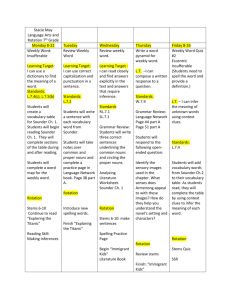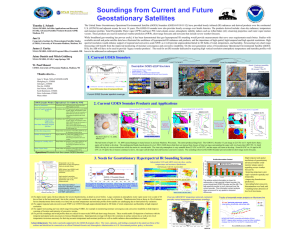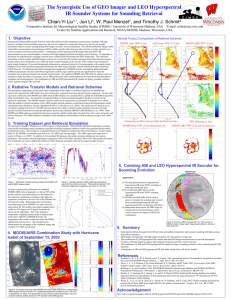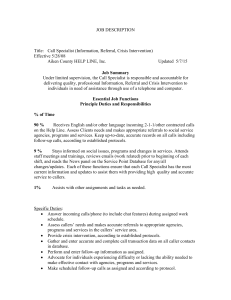Comparisons between GOES and LEO hyperspectral IR soundings over CONUS
advertisement
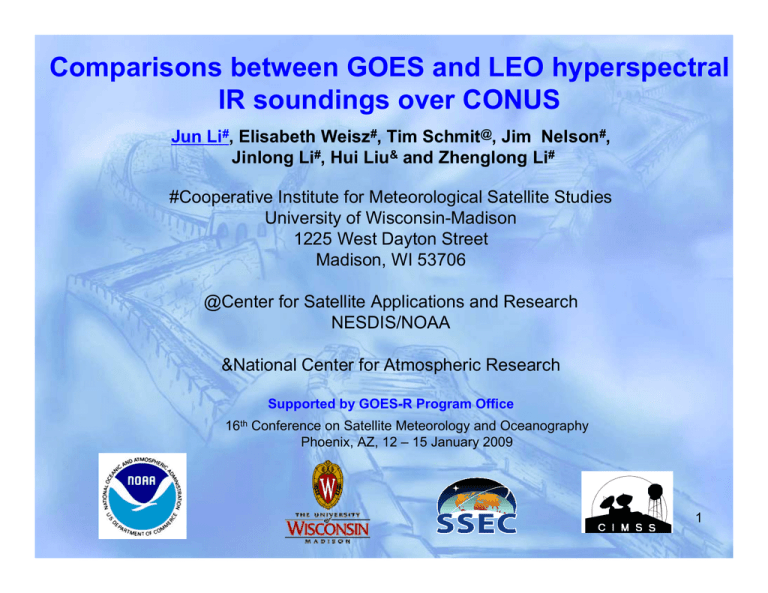
Comparisons between GOES and LEO hyperspectral IR soundings over CONUS Jun Li#, Elisabeth Weisz#, Tim Schmit@, Jim Nelson#, Jinlong Li#, Hui Liu& and Zhenglong Li# #Cooperative Institute for Meteorological Satellite Studies University of Wisconsin-Madison 1225 West Dayton Street Madison, WI 53706 @Center for Satellite Applications and Research NESDIS/NOAA &National Center for Atmospheric Research Supported by GOES-R Program Office 16th Conference on Satellite Meteorology and Oceanography Phoenix, AZ, 12 – 15 January 2009 1 Outline GOES Sounder data and applications Sounding comparisons between GOES and AIRS Why hyperspectral IR sounder on GOES satellite ? Demonstration of GEO hyperspectral IR sounder and applications 2 T – WFs Advanced Sounder T -WFs GOES Sounder W – WFs Advanced Sounder W –WFs GOES Sounder 3 Low vs High Spectral Resolution The current GOES Sounder has only 18 IR spectral data points, while a high spectral resolution sounder may have between 800 and 8000 spectral points. The broad-band nature of the current GOES limits the vertical resolution. 4 Spectral coverage (18 IR + 1 Visible band) for current GOES Sounder 5 Current Sounder Operational Uses GOES Sounder Product Operational Use within the NWS Clear-sky Radiances Assimilation into NCEP operational regional & global NWP models over water Layer & Total Precipitable Water Assimilation into NCEP operational regional & global NWP models; display and animation within NWS AWIPS for use by forecasters at NWS WFOs & National Centers in forecasting precipitation and severe weather Cloud-top retrievals (pressure, temperature, cloud amount) Real Time Mesoscale Analysis (RTMA) Assimilation into NCEP operational regional NWP models; display and animation within NWS AWIPS for use by forecasters at NWS WFOs; supplement to NWS/ASOS cloud measurements for generation of total cloud cover product at NWS/ASOS sites Surface skin temperature Image display and animation within NWS AWIPS for use by forecasters at NWS WFOs Profiles of temperature & moisture Display (SKEW-Ts) within NWS AWIPS for use by forecasters at NWS WFOs in forecasting precipitation and severe weather Atmospheric stability indices Image display and animation within NWS AWIPS for use by forecasters at NWS WFOs in forecasting precipitation and severe weather Water Vapor Winds Image display and animation within NWS AWIPS for use by forecasters at NWS WFOs 6 AWIPS Display Lifted Index from T/q soundings in clear skies Total Precipitable Water Cloud-Top Height Surface Skin Temperature 7 AIRS granules (ascending only) for 06-10-2008 AIRS Granule AIRS Start Time 06-10-2008 20 UTC, Temperature at 700 hPa (K) (K) GOES Sounder + GFS AIRS single field-of-view retrievals in both clear and cloudy skies AIRS + GFS GFS forecast (first guess for GOES and AIRS) 06-10-2008 20 UTC, Humidity [g/kg] at 700 hPa GOES Sounder + GFS AIRS single field-of-view retrievals in both clear and cloudy skies AIRS + GFS GFS forecast (first guess for GOES and AIRS) GOES/AIRS comparison of TPW (06-10-2008, 20UTC) GOES Sounder TPW in clear skies AIRS TPW in clear skies Although patterns are similar, there are still TPW differences between GOES Sounder and AIRS due to different spectral resolutions 11 GOES/AIRS comparison of LI (06-10-2008, 20UTC) Cloudy GOES Sounder LI in clear skies AIRS LI in clear skies Cloud mask differences are due to the different spatial resolutions between AIRS (13.5 km at nadir) and GOES Sounder (10 km at nadir) 12 13 Why GEO hyperspectral IR sounding system ? To support regional and convective-scale NWP over CONUS, through unprecedented detail on 3D fields of wind, temperature and humidity, at high vertical, horizontal and temporal resolution. To support nowcasting and very-short range forecasting (VSRF). For example, to use 3D fields of wind, temperature and humidity for monitoring moisture convergence and convective instability, to help improve warnings of location and intensity of convective storms. High spatial and temporal resolution GEO soundings with high accuracy provide important information for hurricane track and intensity forecast. This has been demonstrated by single field-of-view AIRS soundings. 14 AIRS measurements overlay on GOES IR image (Hurricane Dean) LEO data have limitation on monitoring hurricane due to orbital gap and low temporal resolution. Why GEO? We can have data almost anytime, anywhere ! High temporal resolution is unique aspect of GEO IR measurements A geostationary hyperspectral sounder could provide full hourly disk coverage15 rather than the partial coverage available with polar orbiting sounders. Retrieved 500 hPa temperature (2008.09.06 – Used in assimilation) (K) (K) CIMSS/UW Clear sky AIRS SFOV temperature retrievals at 500 hPa on 06 September 2008, each pixel provides vertical temperature and moisture soundings. These data are used in Hurricane Ike (2008) forecast. 16 Retrieved 500 hPa temperature (2008.09.07 - Used in assimilation) (K) (K) CIMSS/UW Clear sky AIRS SFOV temperature retrievals at 500 hPa on 07 September 2008, each pixel provides vertical temperature and moisture soundings. 17 Assimilation Experiments NCAR WRF/DART ensemble assimilation is performed at 36 km resolution during September 6-8 00UTC, 2008. NCEP 1 degree global analysis is used as initial condition. CTL run: Assimilate radiosonde, satellite cloud winds, aircraft data, ship, and land surface data. AIRS (CIMSS) run: Same as CTL run plus CIMSS single field-of-view AIRS T and Q soundings (13.5 km at Nadir). Ensemble analysis is generated every 6 hours. 18 Tracks of ensemble mean analysis on Hurricane IKE CTL run: Assimilate radiosonde, satellite cloud winds, aircraft data, and surface data. AIRS Hui Liu (NCAR) and Jun Li (CIMSS) Analysis from 06 UTC 6 to 00UTC 8 September 2008 19 Track errors of on Hurricane IKE AIRS Hui Liu (NCAR) and Jun Li (CIMSS) Analysis from 06 UTC 6 to 00UTC 8 September 2008 20 SLP Intensity on Hurricane IKE AIRS Hui Liu (NCAR) and Jun Li (CIMSS) Analysis from 06 UTC 6 to 00UTC 8 September 2008 21 Demonstration of GEO advanced sounder for storm nowcasting The IHOP (June 12, 2002) numerical model output (WRF, 2 km, 15 minutes) are used to simulate the radiances of ABI/GOES Sounder like and GEO HES like instruments Retrieval method is applied to convert the radiances into temperature and moisture profiles Derived product (e.g., Lifted Index) from true (WRF), HES like, ABI/GOES Sounder like are demonstrated along with the simulated Radar imagery Moisture profiles from HES like and ABI like are compared with true, HES like depicts detailed and accurate moisture vertical structures. 22 HES like True Red = extreme instability Simulated Radar ABI/GOES Sounder like 23 True GEO Advanced Sounder 24 Summary Current GOES Sounder provides useful information for severe weather forecast over CONUS, comparisons between GOES Sounder and AIRS show that both provide similar TPW but AIRS provides much better vertical moisture structures High spatial and high temporal GEO advanced sounder can provide needed instability and warning information hours early than the current GOES Sounder Radar shows information after storm development GEO advanced sounder can significantly improve hurricane track and intensity forecast 25
